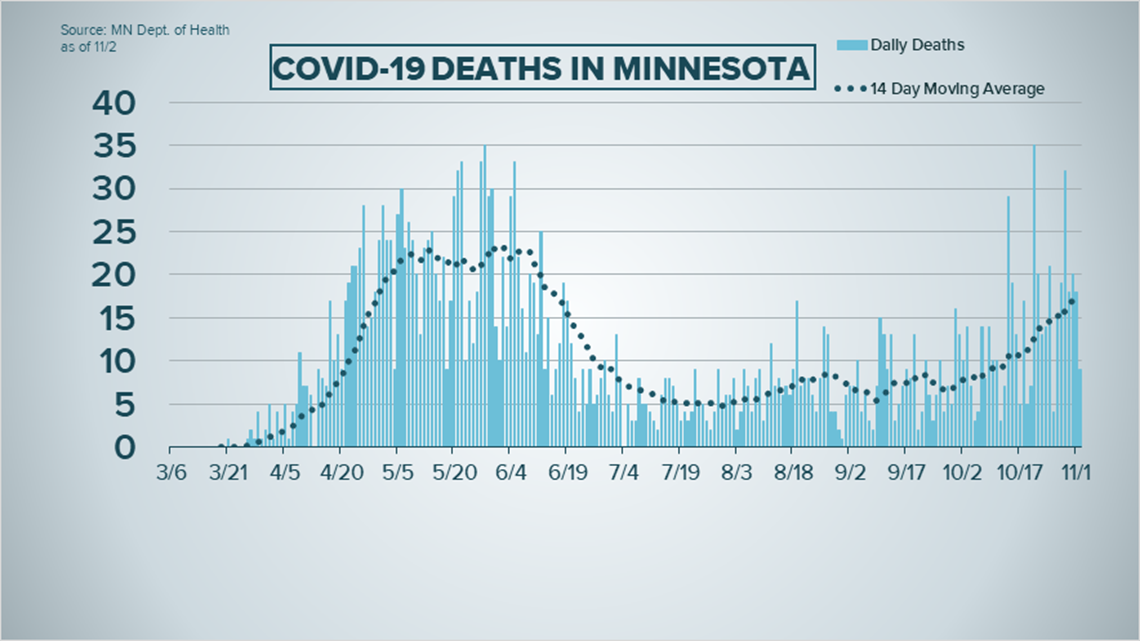Monday, Nov. 2
- Inmate at Stillwater Prison dies of COVID-19
- Daily cases rise above 3,000 in Minnesota a second time
- School districts revisit learning models as COVID spikes
- Case surge beginning to reach long-term care facilities
2 p.m.
In a press briefing on Monday, MDH Commissioner Jan Malcolm said that since Friday, Minnesota has added more than 8,000 cases of COVID-19, and the state has suffered another 47 deaths due to the virus. However, she continued that trends cannot be directly determined from daily numbers.
"I just want to note, as I have before, that there is some variability in number of cases reported on any given day," Malcolm said. "This does not mean any data is lost or incorrect, but sometimes cases that we would have reported one day are reported a day or two later. That was the case with the lower numbers yesterday, which are being reported today and tomorrow."
She said that longer-term tracking, looking at case growth over a week or longer, is a better indication of how COVID-19 cases are trending in Minnesota.
Malcolm also said that in the week of Oct. 24, there were 95 workplace outbreaks in Minnesota, up significantly from the week before. These outbreaks just count the cases of employees, not costumers.
MDH Infectious Disease Director Kris Ehresmann said that test positivity has been increasing across the state, and noted that all of the top 12 counties with the highest case growth are outside of the metro area.
"We are not seeing these increases due to any particular cause," she said. "We want people to realize that these high numbers of cases that we're seeing cannot be attributed to a particular event. It's due to widespread transmission across all sectors, and across the community."
She also said that MDH is concerned about people not wanting to share personal information with state contact tracers. In addition to masking, physical distancing and avoiding large groups, she said MDH needs Minnesotans to provide crucial information and answer contact tracing questions to help reduce risk of transmission.
"Minnesota is in a bad spot due to rapid community spread, and it's going to get worse before it gets better," Ehresmann said. "It's up to all of us to determine whether we'll be in a crisis like our neighboring states, or make decisions to stop the spread."
When asked if MDH has made any additional effort to regulate events such as weddings and funerals, which might fall under the state guidelines for recommended gathering limits but are contributing to community spread of the virus, Malcolm said that the state is continuing to consider its guidance.
"Our main tool is education, reaching out to the relevant sectors and making sure the vendors and proprietors of venues know how important the gathering limits are," Malcolm said. "But we do continue to look at those gathering guidance limits in the light of community transmission."
Ehresmann added that while venues are trying to follow the state's guidance, guests or hosts often ignore it.
"We need people to be following the guidance themselves," she said. "Simply doing as we ask, masking and social distancing, would be huge, and would keep us from having to take action that would be stronger."
Regarding the outbreak at Stillwater prison, Ehresmann said that MDH is very concerned about cases at Minnesota correctional facilities, and has been working closely with the Department of Corrections since the beginning of the pandemic.
"We see cases introduced usually through staff, as a result of community transmission," she said. "Our partners in corrections have been taking this very seriously since the start of the pandemic, and what they've been seeing is that there are a number of facilities that are very old. Their physical environment does not lend itself to good airflow, being able to isolate people easily, which puts a lot of challenges on corrections staff. They're limited to action that might not be as ideal because of the physical setting where these cases are happening."
11 a.m.
Numbers released Monday by the Minnesota Department of Health (MDH) show nearly 3,000 additional Minnesotans were confirmed to be infected with COVID-19 in the past day.
MDH says 2,954 new cases were reported, based on 37,429 tests (both PCR and antigen) processed in private and state labs. Minnesota has now recorded 153,620 cases of coronavirus since the start of the pandemic, with 686 of those defined as probable cases diagnosed with antigen tests.
An additional nine people have died from the virus, bringing the state's total fatalities to 2,484. Of those deaths 1,734, or 70% of them, occurred in long-term care or assisted living settings.


Total hospitalizations in the state related to COVID-19 are now up to a cumulative count of 10,437, with 2,729 of those patients requiring care in the ICU. MDH reports 132,125 people who at one time tested positive for the virus have recovered to the point they no longer need isolation.
Those between the ages of 20 and 24 make up the largest grouping of coronavirus cases by a significant margin, with 18,654 cases and one death, followed by people from 25 to 29 with 14,887 cases and three deaths. Those from 30 to 34 account for 13,555 cases and nine deaths.
The state's largest number of fatalities involves people between 85 and 89, with 438 deaths from the virus in 2,074 diagnosed cases.
Hennepin County reports the most COVID activity with 37,513 cases and 1,004 deaths, followed by Ramsey County with 15,547 cases and 384 deaths. Dakota County reports 10,933 cases and 139 fatalities.
Cook County in northeastern Minnesota has the least COVID activity with 25 cases and zero deaths since the pandemic began, while Lake of the Woods County reports 53 cases and one death.
Sunday, Nov. 1
2 p.m.
Wisconsin's Department of Health Services (WDHS) reported 3,493 new cases on Sunday, bringing the total number of confirmed cases statewide to 228,863.
Health officials reported 59 new deaths on Sunday as the total number of fatalities statewide rose to 2,047. The total number of fatalities is approximately 0.9% of those testing positive for the virus.
Wisconsin health officials say a total of 11,497 people have been hospitalized from the coronavirus since the start of the pandemic, about 5% of the total number of people who have been diagnosed with the virus.
Of the confirmed cases in Wisconsin, 21% involve people between the ages of 20 to 29, 16% are between 30 and 39, 15% are between 50 and 59, and 14% are 40 to 49. An estimated 11% are between 10 and 19, and 10% are between 60 and 69.
As of Sunday, Milwaukee County reported the largest number of cases with 43,482 along with 593 deaths. Brown County has reported 16,210 cases and 103 deaths, and Dane County has reported 16,011 cases and 49 deaths.
A more detailed breakdown of cases by county can be found on the DHS website.
11 a.m.
The Minnesota Department of Health (MDH) announced Sunday that the number of positive coronavirus (COVID-19) cases in Minnesota has increased by 2,217 bringing the cumulative total to 150,672.
Eighteen more people died, bringing the death total to 2,475 in the state.
To date, 10,334 Minnesotans have been hospitalized with the coronavirus since the pandemic started, with 2,706 of them needing care in the ICU.
MDH reports that 129,663 people once diagnosed with the virus have recovered enough that they no longer need isolation.
Of those who have tested positive, people between the ages of 20-24 account for the most cases with 18,336 cases and one death, and ages 25-29 follow with
14,602 cases and three deaths. Those between 85 and 89 years old account for the highest number of fatalities in one age group with 437, out of 2,034 confirmed cases.
In terms of likely exposure to the coronavirus, MDH says 37,567 cases were the result of community transmission with no known contact with an infected person, and 32,908 had known contact with a person who has a confirmed case.
A total of 15,783 cases involved exposure in a congregate living setting, 3,086 were in a corrections setting, and 408 were in a homeless shelter. MDH data shows 11,664 were linked to an outbreak outside of congregate living or health care.
MDH says 13,568 cases were linked to travel. Health care workers or patients account for 4,829 of diagnosed COVID-19 cases. The source of transmission for 30,859 cases is still unknown or missing.
MDH has prioritized testing for people in congregate care, hospitalized patients and health care workers, which may impact the scale of those numbers. However, now MDH is urging anyone who is symptomatic to be tested. Testing locations can be found online.
Hennepin County has the most cases in the state at 36,827 cases with 1,002 deaths, followed by Ramsey County with 15,200 cases and 383 deaths. Dakota County reports 10,693 cases and 139 deaths.
KARE 11’s coverage of the coronavirus is rooted in Facts, not Fear. Visit kare11.com/coronavirus for comprehensive coverage, find out what you need to know about the Midwest specifically, learn more about the symptoms, and see what businesses are open as the state slowly lifts restrictions. Have a question? Text it to us at 763-797-7215. And get the latest coronavirus updates sent right to your inbox every morning. Subscribe to the KARE 11 Sunrise newsletter here. Help local families in need: www.kare11.com/give11.
The state of Minnesota has set up a data portal online at mn.gov/covid19

